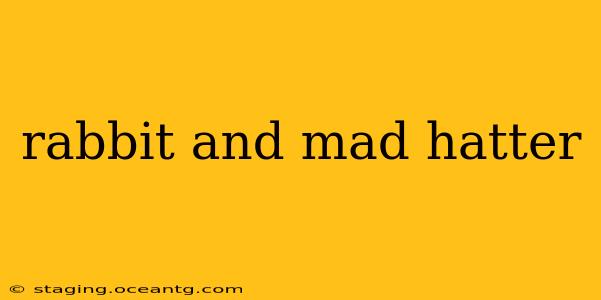The Mad Hatter and the March Hare. These two iconic characters from Lewis Carroll's Alice's Adventures in Wonderland have captivated readers for generations. Their nonsensical conversation, eccentric behavior, and overall air of chaotic absurdity have cemented their place in popular culture. But beyond the whimsical surface, lies a deeper meaning, a commentary on societal norms, and perhaps even a reflection of mental health struggles. This exploration delves into the intricacies of their relationship and the enduring appeal of these unforgettable characters.
Who are the Mad Hatter and the March Hare?
The Mad Hatter, with his perpetually crooked hat and tea-stained fingers, is often considered the more prominent of the two. He embodies the unpredictable nature of madness, his actions and words often defying logic and reason. The March Hare, on the other hand, acts as a foil, amplifying the Hatter's eccentricities with his own brand of frantic energy and nonsensical pronouncements. Their symbiotic relationship thrives on absurdity, creating a whirlwind of chaotic fun and philosophical questioning.
What is the Significance of Their Tea Party?
The Mad Hatter's tea party, arguably the most famous scene involving these two, is more than just a whimsical gathering. It’s a commentary on societal constraints and the absurdity of rigidly adhering to social norms. The perpetually late tea party, the nonsensical conversation, and the illogical nature of the proceedings all serve to highlight the futility of adhering to meaningless rituals and the liberating potential of embracing chaos. The changing size of the table and the endless cups of tea symbolize the cyclical and ultimately pointless nature of their existence, mirroring the anxieties of Victorian society.
Why are the Mad Hatter and March Hare so popular?
Their enduring popularity stems from several factors:
-
Relatability: Despite their eccentricity, the Mad Hatter and March Hare exhibit relatable human traits. Their struggles with conformity and their search for meaning resonate with audiences who find solace in embracing the unconventional.
-
Escapism: The nonsensical world they inhabit offers a refreshing escape from the pressures of reality. The playful absurdity provides a sense of freedom and allows for an exploration of imagination without judgment.
-
Subversion of Norms: Their defiance of societal expectations and their embrace of the illogical appeals to those who feel stifled by convention and yearn for self-expression.
-
Enduring Mystery: The ambiguity surrounding their characters keeps them fascinating. Their precise motivations and backgrounds remain largely undefined, leaving ample room for interpretation and endless fascination.
What is the psychological interpretation of the Mad Hatter and March Hare?
Some interpretations suggest that the Mad Hatter's character may reflect the effects of mercury poisoning, a common occupational hazard for hatters in Victorian England. This aligns with the Hatter's erratic behavior and his distorted perception of reality. The March Hare, on the other hand, is often seen as embodying a manic energy, reflecting aspects of bipolar disorder. However, it is crucial to remember that these are interpretations and not definitive diagnoses. Carroll's work offers fertile ground for psychological speculation, and readers are encouraged to form their own conclusions.
Are the Mad Hatter and March Hare based on real people?
There is no definitive evidence that the Mad Hatter and March Hare were based on specific individuals. However, Carroll’s writing was deeply influenced by his personal experiences and observations of Victorian society. He likely drew inspiration from various sources, weaving together real-world observations with imaginative flights of fancy. The characters' enduring appeal suggests a universality in their portrayal of human experience.
Conclusion: Beyond the Teacups and Top Hats
The Mad Hatter and March Hare are more than just whimsical characters in a children's story. They represent a powerful critique of societal norms, a celebration of imagination, and a reflection on the complexities of human experience. Their enduring appeal lies in their ability to both entertain and challenge us, reminding us of the liberating potential of embracing the absurd and questioning the constraints of conformity. Their legacy continues to inspire artists, writers, and audiences alike, proving their relevance across time and cultures.
